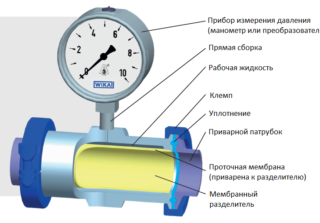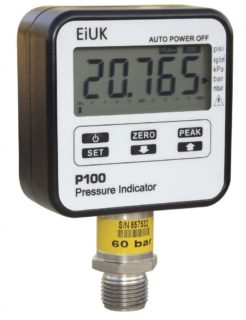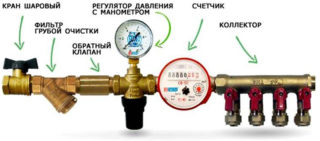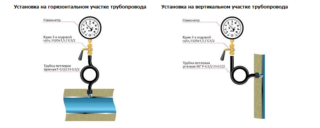A pressure gauge is a device for measuring the pressure of water in a water supply system. With its help, accurate indicators of the working environment are obtained at any section of the pipeline. Depending on the operating conditions, there are several types of such sensors.
Manometer device for measuring water pressure

The pressure gauge has a simple design. In the device, a body and a scale are distinguished on which the measured values are marked. There is a tubular spring in the housing. It can be replaced by a two-plate membrane. The manometer has a holder, a sensitive element and a tribko-sector mechanism.
The arrow of the device is an indicator. It can make one revolution around its axis. Gears are used to transfer rotation to the arrow. The device contains a toothed sector and a leash. There is a special spring between the gears and the teeth of the device, which eliminates the possibility of a backlash.
Classification of pressure gauges and principle of operation

Depending on the features of the operation, pressure measuring devices are classified into the following types:
- Reciprocating. They include a cylinder in which the piston is located. During operation, the medium acts on one part of the pump, and the load presses on the other. The slider moves by moving the arrow. It shows a certain value on the scale of the device.
- Liquid. They contain a tube with a liquid and a movable plug. When using such a device, the working medium presses on the plug, changing the liquid level in the tube. The arrow of the device is set in motion.
- Deformation. Inside such products there is a membrane, which, when deformed, activates the pointer above the scale.
Modern pressure measuring devices are divided into mechanical and electronic. In the first case, the design of the device is as simple as possible. The electronic pressure gauge contains a contact assembly that can more accurately measure the pressure of the working medium. Such devices are widely used in industry. They are used as exemplary models for checking pneumatic assemblies and adjusting regulators in various automated systems. Many electronic pressure gauges record pressure peaks over a period of time.
Depending on the features of work, devices are:
- Stationary - installed only on certain units. It will not work to dismantle such pressure gauges. Often a water pressure regulator is used with them.
- Portable - can be installed on different units and used in different systems. A distinctive feature of the models is their small size.
Many of the pressure gauges are used in heating systems in country houses and apartment buildings. Others are used to service industrial facilities.
Installation features

Installation of a pressure gauge is possible only at a facility with a vented pressure. The device is installed in the working position. Usually it is written in the instructions. It also specifies installation tolerances. Installation of the pressure gauge is carried out using a wrench. In order not to overload the device case, it is necessary to ensure that the tightening torque does not exceed 20 N * m.
You can install a pressure gauge to measure the pressure of water in the water supply in the following ways:
- Straight. The device is mounted in the places indicated in the design documents, for example, before and after the valves.An adapter is placed at the installation point. It is connected to the pipeline by welding or screwing. The pressure gauge is installed in a direct way in cases where the system is stable, without pressure surges.
- With the use of a three-way valve. If the measurement data needs to be checked for atmospheric pressure, a three-way valve is installed for this purpose. Atmospheric air is supplied through it. Replacing a pressure gauge installed in this way does not require interruption of the medium supply.
- Using an impulse tube. It protects the gauge mechanism from pressure drops. An adapter must be used to install the device. Then a tube, a three-way valve and the sensor itself are placed on the pipeline. This method is used in cases where the working environment has a working temperature that exceeds the standard values.
To ensure stable operation of the pressure gauge and reduce the risk of malfunctions, certain installation requirements are met:
- Installation is carried out in such a way that it was easy to take measured values, carry out maintenance and repairs.
- If the pressure gauge is placed at a height of 2-3 m, the body diameter must be greater than 160 mm. Installation of the device at a height of more than 3 m is prohibited.
- A quick check of the pressure sensor can be ensured by installing a three-way valve in the structure, which should be located between the pipe and the pressure gauge.
- When installing equipment under conditions of possible exposure to external adverse factors (high temperature, precipitation), it is necessary to create additional protection for the device. For this task, siphons and buffer elements are selected.
- The sensor is thermally insulated to prevent freezing.
- When connecting a pressure gauge to measure pressure, it is necessary to bleed the gas that has entered the system. To do this, do not tighten the fixing nut on the fitting a little.
Measuring equipment that has not passed the test and does not have a sealed seal on the case is not allowed to be used in communication networks. After the expiration of the verification period, the sensor is removed and sent for diagnostics. If there is a crack on the glass of the device or visible damage to the case, the sensor is disposed of.
After installing the device and putting the system into operation, do not immediately load it. It is better to raise the pressure gradually, avoiding sudden pressure surges. Such measures will extend the life of the sensor.
When installing a manometer for measuring pressure, check the tightness of the connection between the measuring device and the fitting. For this, an FUM tape or thread is usually used. To make the docking place more reliable, a sealant is used. All products must comply with the operating conditions. For example, for superheated steam with a temperature above 130 degrees, it is unacceptable to use an FUM tape, which is designed for a maximum heating of 95 degrees. Some installation companies use tow as an insulator, which should not be allowed.
It is not worth repairing pressure gauges for measuring the pressure in the water supply network yourself. When choosing the type of device, it is important to study the communication parameters in which it will be used.









